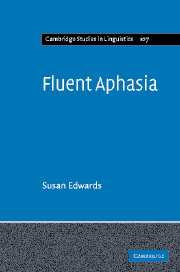Book contents
- Frontmatter
- Contents
- List of figures
- List of tables
- Acknowledgements
- Introduction
- 1 Fluent aphasia: identification and classic descriptions
- 2 Descriptions of fluent aphasia
- 3 Assessment and fluent aphasia
- 4 Connected fluent aphasic speech
- 5 Non-fluent and fluent aphasic speakers. What are the differences?
- 6 Comprehension and processing problems in fluent aphasia
- 7 The manifestation of fluent aphasia in one speaker
- 8 Some concluding thoughts
- References
- Index
6 - Comprehension and processing problems in fluent aphasia
Published online by Cambridge University Press: 22 September 2009
- Frontmatter
- Contents
- List of figures
- List of tables
- Acknowledgements
- Introduction
- 1 Fluent aphasia: identification and classic descriptions
- 2 Descriptions of fluent aphasia
- 3 Assessment and fluent aphasia
- 4 Connected fluent aphasic speech
- 5 Non-fluent and fluent aphasic speakers. What are the differences?
- 6 Comprehension and processing problems in fluent aphasia
- 7 The manifestation of fluent aphasia in one speaker
- 8 Some concluding thoughts
- References
- Index
Summary
Introduction
Tests of comprehension give some insights into language abilities, highlighting the components of language that have been preserved, as well as those that are damaged. A different picture may emerge from that formed by looking solely at production data, but observed differences do not necessarily support the view that differences in performance indicate separate representation for input and output, as we have discussed in previous chapters. Differences may arise because of problems that compound the central language deficit. Problems at the phonological/phonetic level of representation can interfere with the pronunciation of words and thus we would not necessarily expect production and comprehension abilities to be parallel in all tasks. But, in the absence of pronunciation problems, we would expect problems with, for example, understanding certain syntactic structures or certain lexical items to be reflected in production tasks if there is a common central language module. In fact, to date, there is no convincing evidence that production and comprehension deficits do parallel one another, especially in agrammatic aphasia as we have discussed in chapter 5. Differences between production and comprehension abilities in aphasic speakers are taken as evidence that aphasia is a disorder of language processes rather than of language representation. But in fluent aphasia, production and comprehension of complex sentences are often compromised, suggesting that there is some parallelism in this type of aphasia.
- Type
- Chapter
- Information
- Fluent Aphasia , pp. 148 - 173Publisher: Cambridge University PressPrint publication year: 2005



